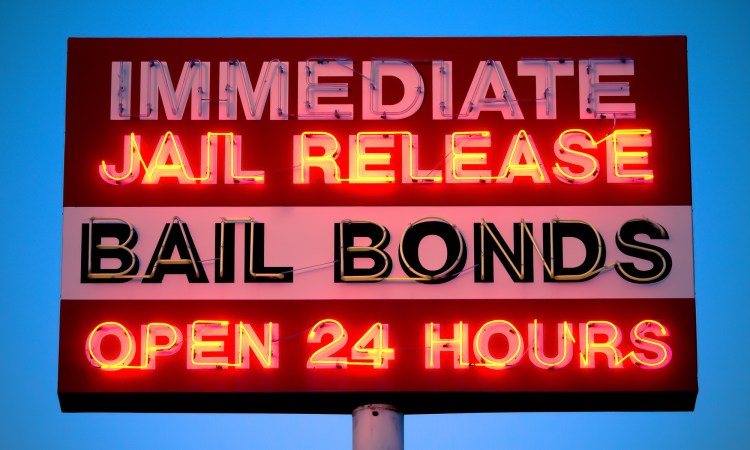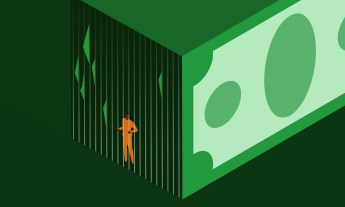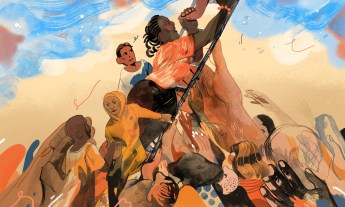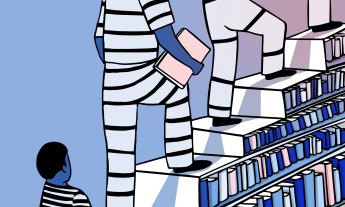
In the United States, nearly 70 percent of the people held in local jails are there for one reason: they don’t have enough money to pay bail. Here’s a look at how this came to be and what it would take to change it.
Here’s a riddle for you. In the past 15 years, the number of people jailed in the US has grown sharply (continuing a steady upward trend that started in the 1980s). But also in the past 15 years, the number of people convicted of crimes has stayed the same. What’s going on?
The alarming answer: More men and women are in jail simply because they can’t afford the price of bail. The crimes they’ve been charged with are often nonviolent — disorderly conduct, a probation violation — and the bail amounts are less than $1,000 — maybe $500 or $750, as Robin Steinberg of The Bail Project explains in her TED talk (What if we ended the injustice of bail?). But when a person can’t come up with the bail money — and a 2017 Federal Reserve report found that 4 in 10 Americans couldn’t cover an unplanned $400 expense — they’re forced to stay in jail until their court date. In the criminal justice system, this is called “pretrial detention,” and it can last for weeks, months or even years.
The United States Constitution says a person is considered innocent until they’re proven guilty — so that means more than 450,000 innocent people are currently in jail, simply because they’re too poor not to be there. “Bail was never intended to create a two-tier system of justice: one for the rich and one for everybody else,” says Steinberg. “But that is precisely what it has done.”
How the heck did this happen?
Bail has been problematic since the beginning. The concept of bail — a payment made by a defendant or their loved ones after their release from jail to ensure that they show up for their trial — is startlingly old; the Roman historian Livy notes its use back in 461 BC. But it became more common in medieval England. Officials did not create the bail system to be used as punishment for a crime; instead, it was meant to give a person a concrete incentive to show up for their trial rather than disappear. But because it ties freedom to the ability to pay, it’s been inherently flawed from the start.
It took Americans to make bail into a big business. A pair of San Francisco brothers, Peter and Thomas McDonough, are credited with taking it to the next level. As the story goes, they were working at their father’s bar when they overheard lawyers talking about loaning their clients bail money and charging them fees. Spotting an opportunity, in 1898 the pair opened McDonough Brothers, a saloon and a bail bond underwriter for people charged at the nearby Hall of Justice. Many competitors and imitators followed suit, advertising their willingness to lend defendants bail money in exchange for fees and interest. Since then, commercial bail bonds have spread, becoming a $2 billion a year industry in the US.
The bail bond business does help some people get out of jail — but it’s also led to ruthless business practices. While the justice system returns bail money in full after a defendant appears in court — whether they’re found innocent or guilty — the fees charged by bail bond agencies (typically 10 percent) are not refunded. What’s more, bail bond agencies can charge high interest rates on their loans, go after a customer’s loved ones for payments, and attach any requirements they want (such as wearing ankle bracelets or taking a house as collateral) to guarantee their investment is recouped. Bail businesses can also turn down clients for any reason — perhaps the person has weak finances or the bond amount is so small that it won’t bring much profit. Perhaps because of the abuses tied to commercial bail bonds, they’re legal in only two countries: the US and the Philippines.
Bail reinforces the racial disparities of the American criminal justice system. African-American and Hispanic people are more likely to be arrested, more likely to be issued bail, and less likely to be able to afford it. And research suggests that bail amounts are similarly biased. For public order crimes (which include things like disturbing the peace and prostitution), the average bail for a Black defendant was $10,000 higher than for a white defendant, according to a 2010 survey of five US cities; for drug crimes, the difference is $13,000. The end result: while African-Americans and Latinos together represent 30 percent of the US population, they comprise 50 percent of those in pretrial detention. Every day they’re in jail, they’re at risk of losing their jobs, housing, immigration status, and even custody of their children, which perpetuates cycles of inequality.
The bail system drives people to plead guilty — even when they’re not. New York City courts processed 365,000 bail hearings in 2013, but less than 5 percent of those cases went to trial. Pretrial detention causes defendants to plead guilty, whether they are or aren’t. But why would an innocent person do that? “Imagine for a moment that it’s you stuck in that jail cell, and you don’t have the $500 to get out,” says Steinberg. “Someone comes along and offers you a way out. ‘Just plead guilty,’ they say. ‘You can go home, back to your job. You can kiss your kids goodnight tonight.’” The cost of pleading guilty is both high and lasting: they end up with a criminal record. But plea deals enable America’s already overwhelmed courts to function. “Let’s not mince words,” says Steinberg: “The current bail system is designed to extract guilty pleas from the most vulnerable people in our society. If people were empowered to demand their right to a fair trial, the system would grind to a halt.”
We can create good alternatives to bail. On August 28, 2018, Governor Jerry Brown of California signed a law that eliminates cash bail. It’s been touted as a victory for bail reform, but in a rush to rethink a broken system, Steinberg warns that California has replaced it with something worse. Rather than cash bail, the state is giving judges the broad discretion to detain people and using algorithm-based risk assessments to determine if people should be held with no hope of being released at all. “This Minority Report approach guts the presumption of innocence,” says Steinberg. She predicts that it will increase the number of those held in pretrial detention and further entrench racial and economic disparities.
Steinberg believes there are better options to ensure people return to court than making them pay or holding them indefinitely. In 2007, she co-founded The Bronx Freedom Fund, a nonprofit that pays bail for New Yorkers who can’t afford it. What they’ve found: Even when bail money is paid by the Fund rather than the client or their family, 96 percent of people still make their court dates. This success rate is driven by an extremely basic strategy: sending reminders. The tactic has been backed up by research: a study released in 2018 found that designing clearer summons forms led to a 13 percent decrease in the failure to appear in court; text message reminders reduced it an additional 26 percent.
Another promising approach: Helping people solve their own problems. In January 2018, Steinberg launched The Bail Project, a national spin-off of the Bronx Freedom Fund that has opened in eight sites so far, from Louisville, Kentucky, to Detroit. In each location, teams of advocates — known as “bail disruptors” — pay clients’ bails and collaborate with them to connect them to social services and help them figure out how to overcome the most common obstacles to appearing in court, such as a lack of transportation or childcare. “It’s ensuring they can fight from a position of liberty and make decisions with their public defenders based on law and evidence rather than desperation,” says Steinberg. Approaching court from a place of freedom leads to incredibly positive results. In 10 years, the Fund has bailed out more than 2,000 people: of them, nearly 60 percent had their cases dismissed outright, and most of the remaining 40 percent had their charges reduced to violations. “Fewer than 2 percent of our clients have ever received a jail sentence of any kind,” says Steinberg.
We can’t undo the long and troubled history of the US bail system. “But it’s time to do something bold,” says Steinberg. We must start, she says, by honoring the words of the Constitution. “The roadmap is there: due process, the right to a fair trial, the presumption of innocence and equal justice under the law,” she says. “These were hard-fought ideals, but it takes all of us to ensure they’re not just empty words on a page or privileges for the few.”
The Bail Project is working to disrupt the US bail system by setting up revolving bail funds in 40 high-needs districts across the country. Become a champion of this idea — one of the first funded by TED’s The Audacious Project — to get involved.











